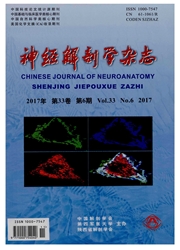

 中文摘要:
中文摘要:
目的探讨暂时性局灶脑缺血后小胶质细胞的反应规律,进一步探讨小胶质细胞在脑缺血损伤中的作用。方法:采用线栓法建立大鼠大脑中动脉阻塞(middle cerebral artery occlusion,MCAO)再灌注模型,应用组织学、免疫组化染色及免疫荧光双标技术,观察大脑中动脉阻塞30 min,再灌注0.5、3、6 h以及1、3、7、14 d和28 d后脑组织的损伤情况,小胶质细胞的形态学和数量变化。结果:组织学观察结果显示:MACO 30 min再灌注0.5 h后,梗死区出现神经元肿胀,脑水肿;再灌注3 h和6 h,脑水肿加重,部分神经元出现核固缩,对侧脑组织也出现水肿。脑水肿和神经元固缩在再灌注1 d时最重。再灌注3 d开始,脑水肿程度逐渐减弱,缺血区浸润的小胶质细胞增多。再灌注7 d时,缺血灶小胶质细胞浸润最明显,伴胶质结节形成,再灌注14 d,胶质瘢痕逐渐减小。再灌注28 d,大多数动物梗死区仅存少量小胶质细胞,个别未能修复的坏死灶液化并形成囊腔。免疫组化和免疫荧光双标记结果显示:假手术组小胶质细胞的胞体小,突起细长柔和。脑缺血30 min再灌注0.5 h可见小胶质细胞的体积增大,突起少而短。缺血再灌注6 h,小胶质细胞的胞体增大,突起减少或消失。再灌注1 d和3 d,小胶质细胞的数量明显多于假手术组(P〈0.05)。再灌注7 d,细胞数量增加达到高峰。再灌注14 d以后,小胶质细胞的数量进一步减少,再灌注28 d后小胶质细胞的数量少于再灌注7 d,但仍多于假手术组和缺血再灌注3 d(P〈0.05)。结论:暂时性局灶脑缺血能够引起小胶质细胞活化和增生,经历损伤性、反应性、效应性和恢复性变化四个阶段。小胶质细胞在脑缺血损伤组织的清除和损伤修复等方面发挥重要作用。
 英文摘要:
英文摘要:
Objective: To observe the pattern of microglial cells activation after transient and focal cerebral ischemia, and further to explore the effect of microglial cell in cerebral ischemia injury. Methods : The transient middle cerebral artery occlusion (MCAO) modal rats were induced by using an intraluminal filament. Histology, immunohistochemistry and doublelabeling were applied to observe the damage and microglial morphology and number changes in the brain induced by 30 rain of transient focal ischemia and 0.5,3, 6 h and 1,3, 7, 14, 28 d of reperfusion, respectively. Results: Histochemical results showed that brain damage appeared after 30 min of MACO and 0.5 h reperfusion, character as cerebral edema and neuronal swelling. At 3 h and 6 h of ischemia and reperfusion ( I/R), cerebral edema deteriorated, neurons karyopycnosis detected in some neurons. Clearly edema also appeared at contralateral brain at this time point. The brain damage gradually enhanced with the process of reperfusion and peaked at 1 day of reperfusion. At 3 days of reperfusion, cerebral edema gradually weakened, the infiltrating glial ceils in the ischemic area increased. The most obvious microglial cells infiltration in the ischemic lesion area appeared at 7 days of reperfusion, with glial nodule formation. The glial scar gradually decreased at to 14 days of reperfusion. When reached 28 days of reperfusion, only few microglial cells were left at ischemic area in most rats. Liquefaction and cysts formed in some individuals that necrotic foci not was fixed. Immunohistochemistry and fluorescence double-labeling results showed that microglial in the sham group was small soma and slender foot. After 30 min of ischemia and 0.5 h of reperfusion, visible microglial volume increases was observed with fewer and shorter processes. At 6 h of I/R, microglial body increased and the processes number decreased or even disappeared. After 1 and 3 days of I/R, the number of microglial in ischemia foci significantly increased compared with the sham gr
 同期刊论文项目
同期刊论文项目
 同项目期刊论文
同项目期刊论文
 期刊信息
期刊信息
